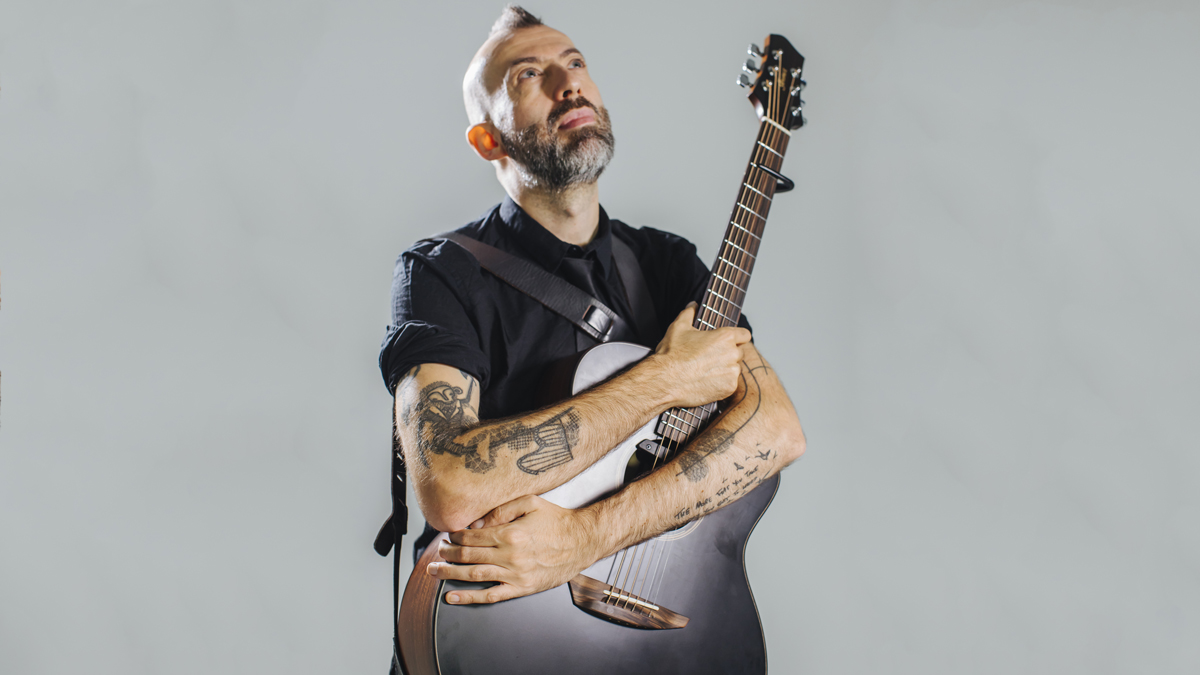
As one of the most innovative fingerstylists on the planet, Jon Gomm knows a thing or two about how to elevate the humble acoustic guitar to extraordinary heights. From beautiful tapestries of natural harmonics to frenzied eight-finger tapping and brain-boggling feats of multitasking, there’s no doubt about it: he’s got the magic touch.
But it can be tricky to know where to begin if you want to move your playing on from open-tuned strum patterns and fingerpicking to a more progressive acoustic style. As Gomm says: “Experimentation is the key. What’s great about modern fingerstyle is that it really means: ‘Pick up an acoustic guitar and do whatever techniques you want, in whatever genre you like.’” Gomm has made an art of doing just that for the last two decades.
Whether you want to unlock a new tuning, start working on your percussive chops or simply choose the right guitar for the job, plunge into this treasure trove of tips and tricks and level-up your skills today.
How would you describe your approach to the guitar?
“I try to approach the guitar as if I’ve never seen one before, and don’t have any preconceptions about how to make sounds with it. If you give a guitar to a little kid, the first thing they’ll do is bang on it like a drum. At the same time, I’ve learned every technique and style I can, and try to mix them all up with no boundaries. It’s a contradiction, but for me it’s the best of all worlds. Acquire the broadest knowledge possible, then forget it all and express yourself.”
I think the acoustic guitar probably has more different drum sounds inside it than any actual percussion instrument.
What are a couple of the most essential techniques in your playing?
“Tapping is the most-used weapon in my arsenal! To me, it sounds great on a steel-string acoustic guitar to hit out the notes with one hand, and it makes it possible to play multiple parts at once. Percussion is the other element.
“I think the acoustic guitar probably has more different drum sounds inside it than any actual percussion instrument. There’s multiple different kicks, snares, toms and bongos, ‘brushes,’ DJ scratches. All we’re missing is the cymbals, but nobody really likes them anyway…”
How would you say your tapping technique differs from what we see in the electric world and what advice do you have for improving that skill?
“The difference is polyphony and range. On an electric guitar with a clean sound, it’s totally possible to use tapping to play chords, or multiple parts, but even then, I don’t think there’s such a difference in timbre between bass notes and melodies, so as to fool the ear into thinking it’s listening to multiple instruments.
“On acoustic guitar I can strum chords with one hand and play a solo by tapping with the other hand, as in my song Until The Sun Destroys The Earth. The most overlooked aspect of tapping technique is dynamics. It’s all in the fingers – no volume controls!
“I like to practice playing one of my tapped riffs and fading it in, from the quietest possible volume to the loudest I can hit it, and back again, very slowly, as if going between 1 and 10 on the volume knob. There’s much less texture in a tapped note than a plucked one, so you have to work harder to make it sound human and real.”
How would you go about finding good kick and snare sounds on the body of an average acoustic guitar?
“The kick drum will be on the loosest, lightest bit of your guitar, so it’ll be on the top – aka soundboard – as far away from the edges as possible. Probably pretty near the bridge. You hit it with your wrist, flat, so it’s a wide area of contact. A thud. The snare will be the tightest, most solid part of the guitar, such as a hand-clap against the side, or slapping the strings against the neck.”
So much great music has been written by people just physically exploring guitars by moving their fingers around to find chords and melodies
How hard do you hit the guitar?
“Softly! Way softer than you probably imagine. For three reasons: Firstly, so you’re less likely to break your guitar. Secondly, so you have a better tone to your drums. Thirdly, to keep the sound and the actual notes in balance.”
What exercises would you suggest for improving coordination, so as to be able to perform basslines, melodies, and rhythms simultaneously?
“Anyone can try this right now: create a rhythmically simple part for one hand, such as tapping some notes in continuous eighth notes or 16th notes with your left hand. Now write it down, in tab or notation. Next, come up with something a bit more rhythmically interesting for the right hand, like a simple drumbeat.
“Now write that down underneath your left-hand tab, marking where each drum hit falls in line with whichever particular left-hand note. Now piece it together with both hands, one moment of music at a time. Before long, you’ll be fluent.”
Most fingerstyle is performed using open tunings, and there are many to choose from. What entry-level favorites would you suggest for someone just venturing out of standard tuning?
“I don’t recommend just sneaking a string or two away from standard tuning. I recommend getting fully lost, by starting with a tuning with no relationship to standard tuning at all, and seeing what happens.
“So much great music has been written by people just physically exploring guitars by moving their fingers around to find chords and melodies. If you don’t think you know enough about music theory to start composing, now you have no excuse to start writing!
“And, if you do know a bunch of theory, let’s see if you really know it. Tune your guitar to B F# D F# A C# and write something in harmonic minor. That’s the tuning and modality of my song Universal Biology. You’ll have to rely on your ear and imagination, instead of your fingers just sleepwalking along pre-learned patterns. Having said all that, if you tune to DADGAD you’ll have a lot of fun. Almost everything sounds wonderful, and there’s a wealth of songs in this tuning you could learn.”
Setting the tuning before you start playing is one thing, but you also incorporate live tuning adjustments into your melodies, as in the song Cocoon. Could you explain what you’re doing and how you’re doing it?
“I play electric guitar, too. Just for fun these days, but I was very serious about it back in the day. I loved the whammy bar work of Jeff Beck, in particular. That true glissando of an open string or harmonic being bent and warped sounds so ethereal on guitar, so pure.
“So, when I saw Adrian Legg doing crazy tuning tricks to achieve similar sounds on acoustic guitar, I had to find out what the fuck was going on. He uses special locking banjo tuners called Keith Tuners.
“I also had this idea that, using tapping, maybe I could use them to bend fretted notes as well as open strings. So I bought some, but they were expensive and I could only afford two. I put them on the treble strings, so I could use them for ghostly Beck-style melodies.”
What qualities should someone look for in an acoustic guitar they intend to use for progressive fingerstyle?
“The top should be strong but lightweight. I love ‘thermo-aged’ wood for this reason: the spruce – the most common wood for guitar tops – is baked in a kiln at a high temperature, so the moisture evaporates, leaving it lighter but without affecting its strength.
“The sound is like a 20 year-old guitar that’s never been played – lower bass, and sparklier trebles. For complex fingerstyle and tapping techniques, a wider neck helps a lot. Not quite a classical width, but not far off. These are some of the ideas we incorporated into my Ibanez JGM signature, but there’s loads more.”
I hate playing on brand new strings, so I avoid changing them for as long as I can!
What gauge of acoustic guitar strings do you use and how regularly do you change them?
“I use 14 to 68 gauge strings. They’re massive. Basically, I climb up telegraph poles late at night, tear down the cabling with my bare hands and use that to string my guitar! Seriously, they’re my signature gauge made by Newtone Strings.
“But I tune them very low, so the tension is actually less than medium gauge strings tuned to regular pitch. I love the bass I can achieve with this setup. Because they’re so heavy and tuned pretty slack, I never break strings. I hate playing on brand new strings so I avoid changing them for as long as I can! But, when I’m touring, a five-gig maximum is my rule of thumb.”

And what is your best tip for getting a good amplified acoustic guitar sound?
“Combining pickups is the thing which will enable you to produce the range of sounds you hear in modern fingerstyle guitar music. Most players will use a transducer – usually affixed to the wood inside the guitar, rather than an ‘undersaddle’ pickup which can sound thin and fake – and an internal microphone – or a magnetic soundhole pickup and a mic, or some other combo.
“I like to use all three, and Fishman kindly designed a triple source system for the JGM guitars. All three elements do different jobs: one is more for the strings, one for percussion, and the other gets both but with an emphasis on the bass frequencies.”
- The Faintest Idea is out now via Kscope.







